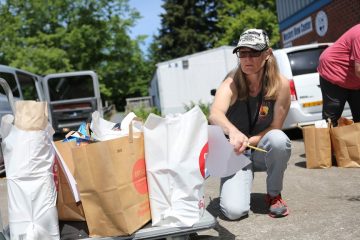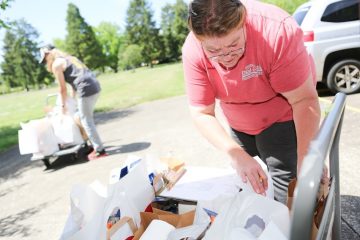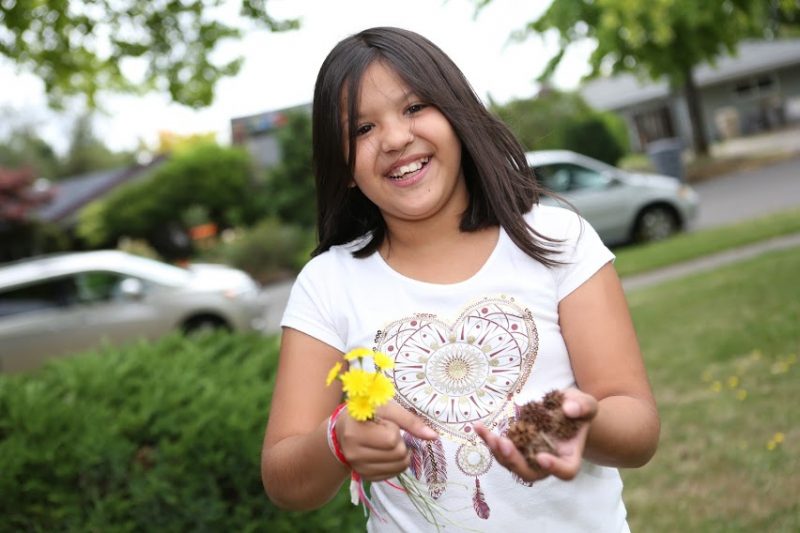This is the first story in a five-part series on how donations to the Corvallis Public Schools Foundation are making a difference in students’ lives and how the Foundation has pivoted to address pandemic-related needs.
They could have taken the summer off.
Instead, a team of more than a dozen Corvallis School District administrators, staff members and teachers invested part of their summer of 2020 working to contact families in need as part of a program dubbed Care and Connect.
By the end of the summer, the Care and Connect team (funded by the Corvallis Public Schools Foundation) had reached out to nearly 300 students and their families to help with needs such as food, hygiene supplies, and housing and rent assistance. And team members found themselves fulfilling another essential human need – giving parents and students a chance to vent during challenging times.
“Some of the families didn’t really need resources,” said Jenna Bowman, an educational assistant at Adams School and a participant in Care and Connect. “But they just really needed someone to vent to and listen to and I feel like those were really meaningful conversations.”
Summer support
Joe Leykam, the Mental Health Program manager for the school district, helped guide the Care and Connect effort. He said earlier work at the district to bolster its mental health services helped plant the seeds for the summer project – even before the COVID-19 pandemic forced the district to close its buildings and pivot to distance learning.
“When we set out to start a mental health program, we had talked a lot, very intentionally, about what summer support” programs could look like, Leykam said.
That helped build the foundation for Care and Connect. But the speed with which the virus struck triggered a “scramble,” as Leykam put it: “We were trying to deploy a lot of different resources,” and it had to be done quickly.
For example, Chris Hawkins, the district’s student support specialist, and her colleagues worked during spring break to create a distribution center (it became known as the “Welcome Center”) in the district’s Western View building where families could pick up food, clothes and hygiene supplies. (The Welcome Center effort also was funded by the Corvallis Public Schools Foundation.)

Meanwhile, Leykam said, Rynda Gregory, a coordinator with the district, was leading a team focused on developing summer resources with an eye on guidance from the Oregon Department of Education.
At the same time, a couple of the district’s principals also were working on their own to cook up ideas for providing summer support for students and families needing it; the foundation offers grants to fund many of the district’s summer projects.
As summer approached, these different strands “sort of crashed into each other,” Leykam said. “In the month of June, we went from zero to 60 pretty fast.”
Leykam said support from the Corvallis Public Schools Foundation and its executive director, Liv Gifford, was essential in getting Care and Connect up and running: “I can’t thank Liv and her board enough for the financial ability to do that.”
A call went out to district employees asking for people to join the Care and Connect effort, prompting what Leykam called an “overwhelming response.” (All the participants were paid for their work.)
“We developed, in the span of a couple of weeks, training and resources for how we would do this and in effect built a very small social-service case-management organization over the span of about three weeks, and that was remarkable.”
Building the team
Members of the Care and Connect team each had different reasons for applying.
Ann Mbacke, an educational assistant at Mountain View School, raised her hand because she thought Care and Connect would help ease a worry she had had since the spring: What were parents going to with their children during the summer, a time when child care wasn’t available (or, for some, affordable) and when some of them were unemployed? “I wanted to be present in any way that I could be, because I understand that struggle,” she said.
“But I believe in community, right?” she said. “So my philosophy is very broad: Whatever we can do, we should do.”
Matthew King, who’s taught English at Corvallis High School for 14 years, had a personal reason for applying: He’s parent to a child “who first came into my life through the foster care system,” he said. “And that’s how I became interested in this whole world of helping advocate for students who are maybe in situations where their needs aren’t being met or where there are some really serious obstacles to being able to engage in school.”
Another Care and Connect caller, Chris Cavagnaro, a mental health trainer with the district, thought the program was a logical extension of work he already was doing. “While I do enjoy having summers off, I realized a commitment to working a couple of days a week to try to help families get what they need during this time. … There’s a lot of families out there that are really struggling in ways that they never have before.”
In all, 17 district employees were involved in Care and Connect during the summer of 2020. They were working with a list of about 380 students to attempt to contact during the summer; that list had been pared down from a list of about 700 students who had been identified earlier by the district as being in a “high-needs situation.”
The act of trimming down that list to a manageable 380 was agonizing, Leykam said. “It’s not so much whether there’s need. It’s just, how much can we help? … How many hours are in the day?”
Making the calls
The Care and Connect staff went through a week of training before beginning to contact students and families – the goal, in essence, was to offer participants a “crash course in the social services sector in our community,” Leykam said.
And there was another important component of the training: Leykam and Gregory hammered home how important it was for the callers to take care of themselves as well.
Said Leykam: “What we were going to be asking people to do was reach out and ask questions like ‘How are you doing?’ ‘How have things been going with your student?’ ‘Do you need food in your house?’ ‘Are you feeling safe?’ ‘What about your rent situation?’ The answers to those questions were not going to be simple yeses or nos. They were going to come with stories, and those stories were going to be hard to hear.”
That’s why Leykam and Gregory emphasized self-care in the training, and offered specific strategies, such as participants themselves permission to take a few minutes after a particularly stressful call to reset emotionally.
Bowman from Adams School gave high marks to the training: “I felt really comfortable and confident to do my job.”
But even that thorough training couldn’t prepare the callers for some of the issues they found themselves confronting.
Mbacke worked to try to find resources for a woman with an undocumented immigration status, which made the woman ineligible for unemployment benefits.
“I mean … here’s a woman who has worked all her life, can’t work, she works as a domestic, doing housekeeping and other types of work and she is limited because of her status, her immigration status. And so, of course, I did everything I could.”
King worked with a family that was in danger of losing its housing – and ended up getting a crash course in federal Department of Housing and Urban Development vouchers. “I had to learn a lot about how HUD vouchers and the housing market works, really quickly,” King said. “And then, I wanted to help them find a place, but it’s really, really difficult – it’s just so hard and so stressful.”
Care and Connect workers also helped family members with food, toiletries, and other assistance, so they could save money for a move.

Avi Hernandez, a sixth-grade teacher at Linus Pauling, had to go outside Corvallis to help one of the families on his list. “There was a family I couldn’t reach at all,” Hernandez said, but he eventually connected with them – and learned why he had had such a hard time reaching them.
The family had moved to Salem – and their dad was in hospice care due to cancer. Technically, because the family was outside the district boundaries, Hernandez had no obligation to help.
But that didn’t stop him. “I didn’t know exactly what to do, other than to try to help in whatever way I thought would be best,” said Hernandez, who also lives in Salem and commutes to his teaching job.
So he asked family members and friends to donate clothes. He went to the Marion Polk Food Share to collect food for the family. He collected toys for the children.
Not every connection resulted in such dramatic needs – and not every family was always happy that they were being contacted.
Mbacke had a difficult time connecting with one student – and when she finally connected with the student’s mother, she had a better understanding of the reason way: “Just having someone ask her if she needed help – and her saying ‘yes’ – was a challenge because she often felt judged because she needed help.”
But King found that “the vast majority of families that I connected with and spoke with were really grateful to be reached out to, really grateful just to talk.”
And he recalled one specific example: a family that had moved to the area just a year ago, with a teenager who had had a hard time making friends. “And so they were doing fine in terms of basic needs, but I’m the parent of a teenager, and we were just able to commiserate together over how tough it is to have a teenager in general and especially in the pandemic.”
After working hard to connect with another family, Hernandez started to worry when he lost connection with them for a time. When he finally reconnected, most of the family members were asleep – but Hernandez relaxed when he discovered the reason why: They had spent the weekend swimming in a lake.
“It was those little moments,” Hernandez said, “just knowing that the families were doing OK.”
Mbacke treasured the moments she was able to spend talking to students: “They were really trying to make it work,” she said. “One student, he was in high school, he got a job at Carl’s Jr. and was volunteering at the Humane Society. I was just happy to hear those kinds of stories too.”
Moving forward
The summertime Care and Connect team has wrapped up its work. But people involved in the project said the need for outreach to students and families in need isn’t going away – and agreed that Care and Connect offers lessons for how to move forward.
“We are all now feeling like we can share what we’ve learned with the other (school) buildings and try to support the students in a very similar way,” Cavagnaro said, “but we’ll be involved in bigger teams where more decisions will be made and hopefully we’ll be able to make a bigger impact.”
For her part, Mbacke said families “appreciated someone calling to check in on them. And I think that’s something we need to carry forward in the ways that we can. Look at it as a thing of balance or harmony.”
King noted that Care and Connect helped to show educators a different way to connect with families, “and particularly how to go about forming that relationship so that families would trust you enough to reveal what their needs were. For some families, the school as an institution isn’t necessarily a welcome presence in their daily lives. … Just knowing that we genuinely want to reach out and care and understand what those needs are will help a lot of families and students engage in schools at a higher level.”
This story was written by Mike McInally, a free-lance writer and the former editor of the Corvallis Gazette-Times.
